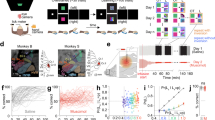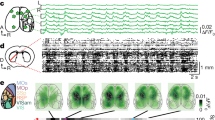Abstract
Primates have the remarkable ability to rapidly adjust or modify associations between visual cues and specific motor responses. Whereas little is known as to how such adjustments in behavioral policy are implemented, recent learning models suggest that the anterior striatum is optimally positioned to have a role in this process. We recorded from single units and delivered microstimulation in the striatum of rhesus monkeys performing an associative learning task. Caudate activity during reinforcement was closely correlated with the rate of learning and peaked during the steepest portion of the learning curve when new associations were being acquired. Moreover, delivering microstimulation in the caudate during the reinforcement period significantly increased the rate of learning without altering the monkeys' ultimate performance. These findings suggest that the caudate is responsible for implementing selective adjustments to the 'associative weights' between sensory cues and motor responses during learning, thus enhancing the likelihood of selecting profitable actions.
This is a preview of subscription content, access via your institution
Access options
Subscribe to this journal
Receive 12 print issues and online access
$209.00 per year
only $17.42 per issue
Buy this article
- Purchase on Springer Link
- Instant access to full article PDF
Prices may be subject to local taxes which are calculated during checkout







Similar content being viewed by others
References
Alexander, G.E. Basal ganglia-thalamocortical circuits: their role in control of movements. J. Clin. Neurophysiol. 11, 420–431 (1994).
Flaherty, A.W. & Graybiel, A.M. Input-output organization of the sensorimotor striatum in the squirrel monkey. J. Neurosci. 14, 599–610 (1994).
Hoover, J.E. & Strick, P.L. Multiple output channels in the basal ganglia. Science 259, 819–821 (1993).
Houk, J.C., Davis, J.L. & Beiser, D.G. eds. Models of Information Processing in the Basal Ganglia (MIT Press, Cambridge, Massachusetts, 1995).
McClure, S.M., Laibson, D.I., Loewenstein, G. & Cohen, J.D. Separate neural systems value immediate and delayed monetary rewards. Science 306, 503–507 (2004).
Pasupathy, A. & Miller, E.K. Different time courses of learning-related activity in the prefrontal cortex and striatum. Nature 433, 873–876 (2005).
Schultz, W. Predictive reward signal of dopamine neurons. J. Neurophysiol. 80, 1–27 (1998).
Fibiger, H.C., LePiane, F.G., Jakubovic, A. & Phillips, A.G. The role of dopamine in intracranial self-stimulation of the ventral tegmental area. J. Neurosci. 7, 3888–3896 (1987).
Wickens, J.R., Reynolds, J.N. & Hyland, B.I. Neural mechanisms of reward-related motor learning. Curr. Opin. Neurobiol. 13, 685–690 (2003).
Reynolds, J.N., Hyland, B.I. & Wickens, J.R. A cellular mechanism of reward-related learning. Nature 413, 67–70 (2001).
O'Doherty, J. et al. Dissociable roles of ventral and dorsal striatum in instrumental conditioning. Science 304, 452–454 (2004).
O'Doherty, J.P. Reward representations and reward-related learning in the human brain: insights from neuroimaging. Curr. Opin. Neurobiol. 14, 769–776 (2004).
Suri, R.E. & Schultz, W. A neural network model with dopamine-like reinforcement signal that learns a spatial delayed response task. Neuroscience 91, 871–890 (1999).
Smith, A.C. et al. Dynamic analysis of learning in behavioral experiments. J. Neurosci. 24, 447–461 (2004).
Wirth, S. et al. Single neurons in the monkey hippocampus and learning of new associations. Science 300, 1578–1581 (2003).
Alexander, G.E. & DeLong, M.R. Microstimulation of the primate neostriatum. II. Somatotopic organization of striatal microexcitable zones and their relation to neuronal response properties. J. Neurophysiol. 53, 1417–1430 (1985).
Aosaki, T., Kimura, M. & Graybiel, A.M. Temporal and spatial characteristics of tonically active neurons of the primate's striatum. J. Neurophysiol. 73, 1234–1252 (1995).
Cohen, M.R. & Newsome, W.T. What electrical microstimulation has revealed about the neural basis of cognition. Curr. Opin. Neurobiol. 14, 169–177 (2004).
Tehovnik, E.J. Electrical stimulation of neural tissue to evoke behavioral responses. J. Neurosci. Methods 65, 1–17 (1996).
Hernandez-Lopez, S., Bargas, J., Surmeier, D.J., Reyes, A. & Galarraga, E. D1 receptor activation enhances evoked discharge in neostriatal medium spiny neurons by modulating an L-type Ca2+ conductance. J. Neurosci. 17, 3334–3342 (1997).
Borland, L.M., Shi, G., Yang, H. & Michael, A.C. Voltammetric study of extracellular dopamine near microdialysis probes acutely implanted in the striatum of the anesthetized rat. J. Neurosci. Methods 146, 149–158 (2005).
Cragg, S.J., Hille, C.J. & Greenfield, S.A. Dopamine release and uptake dynamics within nonhuman primate striatum in vitro. J. Neurosci. 20, 8209–8217 (2000).
Hadj-Bouziane, F. & Boussaoud, D. Neuronal activity in the monkey striatum during conditional visuomotor learning. Exp. Brain Res. 153, 190–196 (2003).
Hollerman, J.R., Tremblay, L. & Schultz, W. Influence of reward expectation on behavior-related neuronal activity in primate striatum. J. Neurophysiol. 80, 947–963 (1998).
Jog, M.S., Kubota, Y., Connolly, C.I., Hillegaart, V. & Graybiel, A.M. Building neural representations of habits. Science 286, 1745–1749 (1999).
Kawagoe, R., Takikawa, Y. & Hikosaka, O. Expectation of reward modulates cognitive signals in the basal ganglia. Nat. Neurosci. 1, 411–416 (1998).
Miyachi, S., Hikosaka, O., Miyashita, K., Karadi, Z. & Rand, M.K. Differential roles of monkey striatum in learning of sequential hand movement. Exp. Brain Res. 115, 1–5 (1997).
Press, W.H., Teukolsky, S.A., Vetterling, W.T. & Flannery, B.P. Numerical Recipes in C++: The Art of Scientific Computing 2nd edn. (Cambridge Univ. Press, Cambridge, UK, 2002).
Schraudolph, N.N. Fast curvature matrix-vector products for second-order gradient descent. Neural Comput. 14, 1723–1738 (2002).
Acknowledgements
We thank E.N. Brown, W.F. Asaad, J.D. Macklis and R. Amirnovin for their thoughtful comments and critical review of the paper. Funding for this project was provided by the National Institutes of Neurological Disorders and Stroke, the Parkinson Disease Foundation and the Harvard Center for Neurodegeneration and Repair.
Author information
Authors and Affiliations
Corresponding author
Ethics declarations
Competing interests
The authors declare no competing financial interests.
Supplementary information
Supplementary Fig.1
Paired choice control task. (PDF 626 kb)
Rights and permissions
About this article
Cite this article
Williams, Z., Eskandar, E. Selective enhancement of associative learning by microstimulation of the anterior caudate. Nat Neurosci 9, 562–568 (2006). https://doi.org/10.1038/nn1662
Received:
Accepted:
Published:
Issue Date:
DOI: https://doi.org/10.1038/nn1662
This article is cited by
-
Single-neuronal predictions of others’ beliefs in humans
Nature (2021)
-
Modelling and prediction of the dynamic responses of large-scale brain networks during direct electrical stimulation
Nature Biomedical Engineering (2021)
-
Dissociable roles of ventral pallidum neurons in the basal ganglia reinforcement learning network
Nature Neuroscience (2020)
-
Dorsolateral prefrontal neurons mediate subjective decisions and their variation in humans
Nature Neuroscience (2019)
-
A New Neural Pathway from the Ventral Striatum to the Nucleus Basalis of Meynert with Functional Implication to Learning and Memory
Molecular Neurobiology (2019)



